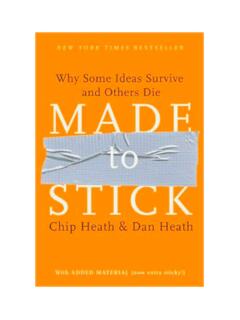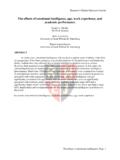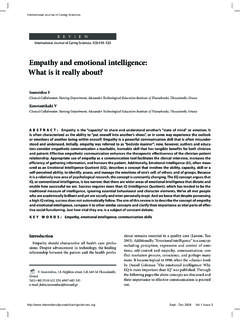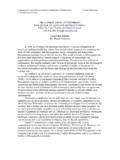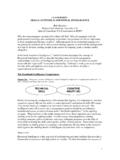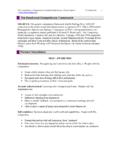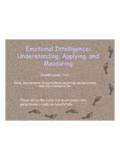Transcription of Connecting Emotional Intelligence to Success in …
1 Part One: A Brief History of Emotional IntelligenceEmotional Intelligence : Roots in IQ MeasurementThe idea of measuring Intelligence took hold in the early part of the twentieth century and resulted in the concept of the Intelligence quotient or IQ, which places people on a bell-shaped curve with the average Intelligence at 100. As Cary Cherniss explains in his article, Emotional Intelligence : What it is and Why it Matters, the early developers of IQ tests understood that non-intellective abilities are as important for predicting an individual s Success in life as those of general Intelligence .
2 David Wechsler, for example, writing in the early 1940 s, asserted that in addition to intellective there are also definite non-intellective factors that determine intelligent behavior and that we cannot expect to measure total Intelligence until our tests also include some measures of the non-intellective factors (Cherniss, 2000). Nevertheless, the IQ test as we know it developed mostly as a measure of mathematical and verbal abilities. In his book, Frames of Mind: The Theory of Multiple Intelligences, published in 1983, Howard Gardner wrote about multiple intelligences, including intrapersonal and interpersonal intelligences, which would later become major aspects of Emotional Intelligence definitions and Emotional Intelligence In the latter decades of the twentieth century, the social and Emotional factors of Intelligence received more attention among researchers.
3 One clinical psychologist, Reuven Bar-On, focused his research by asking a couple of questions: Why do some people succeed in possessing better Emotional well-being than others? Why are some individuals more able to succeed in life than others? Bar-On performed a systematic review of various abilities, capabilities, competencies, and skills that are generally thought to determine Success as well as gaining and maintaining positive Emotional health. His research revealed that what we call IQ, basically cognitive Intelligence , is not always the sole predictor of Success .
4 Bar-On developed the Emotional Quotient Inventory (EQ-i), defining Emotional Intelligence as an array of non-cognitive capabilities, competencies and skills that influence one s ability to succeed in coping with environmental demands and pressures (Bar-On, 1998).Other psychologists, including Peter Salovey and John Mayer who receive credit for coining the term Emotional Intelligence , were researching similar concepts, however, it was Daniel Goleman, a science writer for the New York Times and a Harvard-trained psychologist, who wrote and published the book Emotional Intelligence : Why It Can Matter More than IQ in 1995, greatly boosting popular interest in Emotional Intelligence .
5 Goleman attempted to demonstrate that emotions play a significant role in thought processes and decision making, and that Emotional Intelligence is an important factor to individual Success . He defined Emotional Intelligence as a set of skills, including control of one s impulses, self-motivation, empathy and social competence in interpersonal relationships. Connecting Emotional Intelligence to Success in the WorkplaceConnecting Emotional Intelligence to Success in the WorkplaceBarbara A. Kerr, , author of Creating an Emotionally Intelligent World: A Computer-Based Game for Teams, published by HRDQ Copyright HRDQ, 2009 Connecting Emotional Intelligence to Success in the Workplace Copyright HRDQ, 2009 Since Goleman s 1995 book, there has been a great deal of research and published writing about Emotional Intelligence including several other books written by Daniel Goleman either on his own or in collaboration with others.
6 His book, Social Intelligence (2006) makes the case for the social brain that is wired to connect with other brains and thereby mold both our experience and our neural circuitry. Goleman asserts, The brain-to-brain link allows our strongest relationships to shape us on matters as benign as whether we laugh at the same jokes or as profound as which genes are (or are not) activated in T-cells, the immune system s foot soldiers in the constant battle against invading bacteria and viruses (Goleman, 2006).
7 An Internet search can easily result in two million or more references to Emotional Intelligence , and a number of organizations have developed that are devoted to studying the concepts and applying them to personal and community life, education, and the workplace. The Consortium for Research on Emotional Intelligence in Organizations at Rutgers University maintains a website ( ) that includes an extensive bibliography of articles and books on this topic. Assessment and Enhancement of Emotional IntelligenceA number of assessments have been developed for measuring both individual and team Emotional Intelligence .
8 One of the oldest and most validated assessments is the EQ-i (mentioned above) developed by Reuven Bar-On, a self-report measure of fifteen different factors divided among five realms that Bar-On has delineated to define Emotional Intelligence . Other assessments purport to test Emotional Intelligence abilities through a presentation of emotion-based problems. A number of other assessments, mainly of the self-report type, have been developed and are widely available. Whatever assessment is used, the purpose for measuring Emotional Intelligence in most arenas is the idea that people can indeed learn ways to enhance their own skills and competencies not only to improve their scores but to be more successful in their personal lives and in achieving their goals in the workplace.
9 The game, Creating An Emotionally Intelligent World, was designed and developed to provide an experience that will provoke participants to understand how their own levels of Emotional Intelligence influence their everyday actions, reactions, and interactions and thus their Model of Emotional Intelligence The Model of Emotional Intelligence , which provides the framework for the game, draws on existing models and research (including Bar-On, Goleman, Freedman, Salovey and Meyer, Cooper and Sawaf) but specifically addresses the workplace and behaviors that contribute to achieving Success in the workplace.
10 The model consists of five dimensions: Awareness of the Self Actions of the Self Awareness of Others Interactions with Others Resilience Figure 1. A Model of Emotional IntelligenceAwareness of the SelfResilienceActions of the SelfInteractions with OthersAwareness of OthersBarbara A. Kerr Copyright HRDQ, 2009 While there are distinct definitions for each of the five dimensions, the competencies of these dimensions are clearly interconnected. For example, most of the competencies are based on Awareness of the Self, the foundational building block of Emotional Intelligence .


